Brancaster Chronicle No.58: Mark Skilton Sculptures
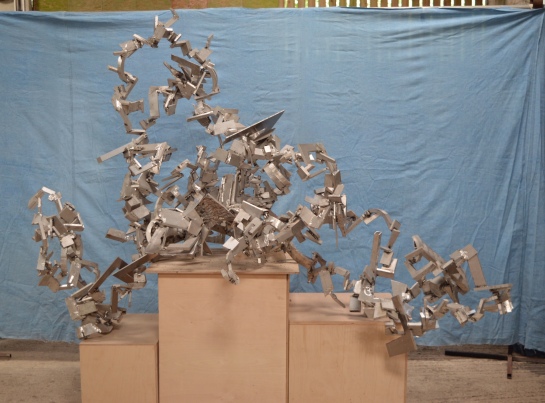
Schrödinger´s Cat Cradle, L 212cmx150cmx163cm
7th July 2018, artist’s studio near Bath.
Taking part: Sarah Greenwood, Robin Greenwood, Anne Smart, Anthony Smart, Noela James, Alexandra Harley, John Pollard, Richard Ward, Charley Greenwood, Shelley Latham, Hilde Skilton, Mark Skilton.
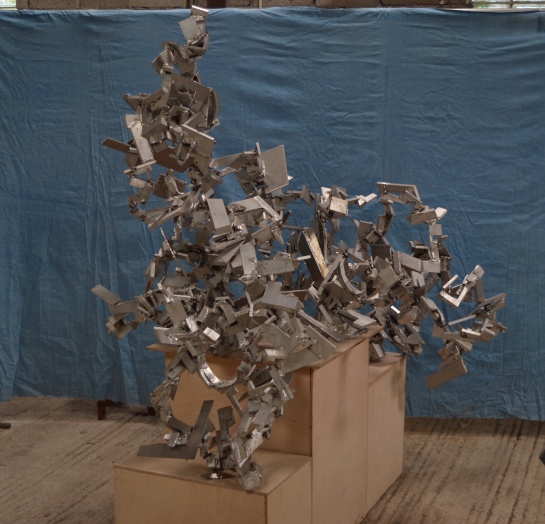
Schrödinger´s Cat Cradle, L212cmx150cmx163cm [view 2]
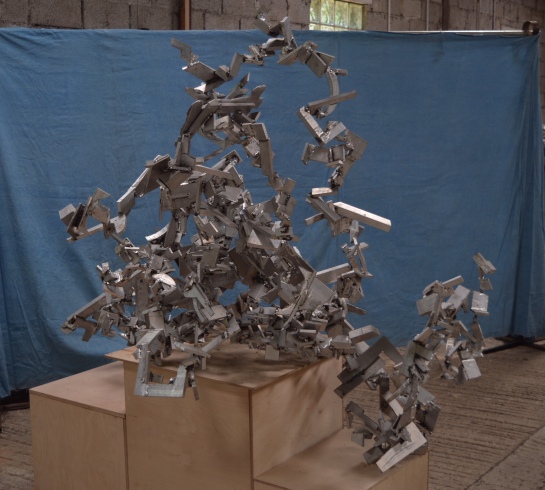
Schrödinger´s Cat Cradle, L212cmx150cmx163cm [view3]
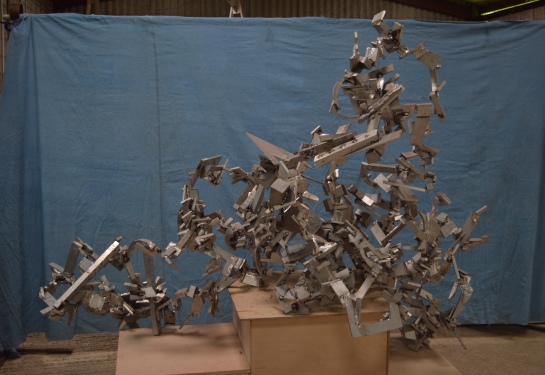
Schrödinger´s Cat Cradle, L212cmx150cmx163cm [view4]
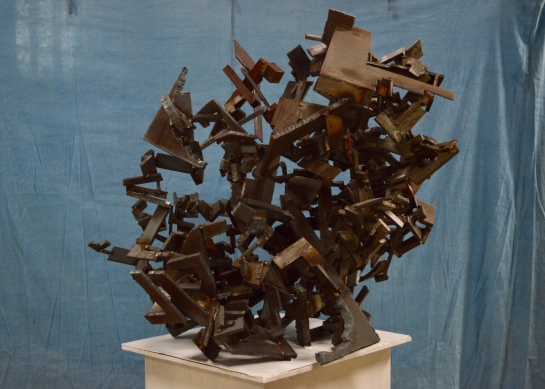
Bashful Boomslang, L138cmxW104cmx115cm

Bashful Boomslang, L38cmxW104cmx115cm [view 2]

Bashful Boomslang, L138cmxW104cmx115cm [view 3]

Bashful Boomslang, L138cmxW104cmx115cm [view 4]

Octopus Odyssey, L243cmxW153cmxH135cm

Octopus Odyssey, L243cmxW153cmxH135cm [view 2]
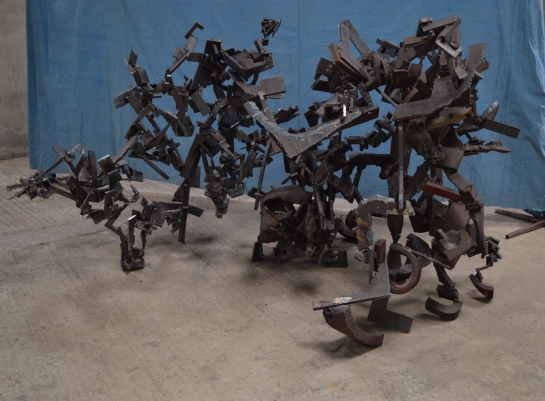
Octopus Odyssey, L243cmxW153cmxH135cm [view 3]
It is interesting to see that the photos of Octopus Odessey don’t highlight what I perceived as a massive difference between the two ‘ends’. I saw a big change in handling and the scale of elements as the sculpture moved across, that really isn’t apparent from the photos
LikeLike
Indeterminacy lives! And in the form of quantum entanglement!!!
Then again, was it ever actually dead? Maybe it just has the possibilities of multiple states of existence – dead, alive and everything in between, though as soon as one or other of us looks at it, it assumes a definitive state of existence, according to our own viewpoints.
To be serious, these crazily ambitious sculptures by Mark see him completely abandoning his previously cherished laws of Newtonian billiard-ball physics and delving into the altogether more challenging but more abstract world of bringing into existence a number of possible realities all at once, without pinning down any of them. I love the aluminium as a material for constructed sculpture. The problem at the current moment of looking at “Schrödinger´s Cat Cradle” is that it is murdered at every juncture by the invasive nature of literal space. It feels embattled by it, made semi-figurative by it, which is what happens when you (necessarily) break up and disembody the clear physical structures of previous sculpture. But that means that at the moment only in the fantastic but geographically separated pockets of activity does it “own” its own sculpturally illusionistic space. There is evidence of this invasion of literal space in the choice of Olympic podium as a base for an object that is wildly out of control on all fronts; even how it stands, if it does, and with the right-hand end not even wanting to know what the left-hand end is doing, etc. and so on, throughout the work. Quite exciting, really. This all might be good but depends upon what will have happened when we next open the box.
“Octopus Odyssey” remains for me a game of three halves, with the content separating because of the unnecessarily imposed complexities of a “big idea” that requires a weirdly Caro-esque-type floor-movement foot-shuffle to fulfil its vision of inward-folding literal space appropriation. I very humbly and respectfully suggest that such large-scale ambitions have to take a back seat to what the actual abstract content is trying to be or say of its own accord – indeterminate or otherwise – even when it is so very brilliant as it is here.
There is so much good stuff to look at in this work, but it seems at least in part to be neurotically dissembling.
LikeLike
Looking at these, and at some of Robin’s and Tony’s (only his most recent) work, a word that springs to mind is “amorphous”. I’m absolutely prepared to accept that I’m missing something new and big and important, but I wonder if all the attention to that amazing abstract content, coupled with an aversion to structure/outline/composition, isn’t happening at a cost to form.
The best comparison I can come up with in painting is
Jackson Pollock. His drip paintings may be wild and ambitious, but they are immediately recognizable as whole things. One is aware of the wealth of detail but there is no necessity to actively engage with the detail in order to appreciate the painting.
It occurs to me that this may partly be so because of having to work within and reflect the constraints of a rectangular frame.
Would some of these sculptures benefit from an additional constraint, additional pressure? Was that constraint in the past the human form? Is Robin’s device of hanging, providing one kind of additional constraint – the necessity of balance rather than the freedom to spread out all over the place with any number of supporting contacts to the ground?
LikeLike
A couple of questions:
“at a cost to form” – what is that? What “form” would you see it taking? Sounds like you want a return to the dreaded “configuration”, or some other dread “known” solution.
You must remember too before laying the blame for what I think is a non-existent problem that both Mark and Tony are at best ambivalent to the whole idea of “abstract content” and approach their work from different ways.
If I were you I’d be a bit more worried that abstract painting perhaps doesn’t (or can’t) engage quite so deeply at the moment with all these brilliant “problems” that Mark’s sculpture is addressing so excitingly. “Amorphous” is yet another negative word that seems to me inappropriate, because to me this is all bursting with structure(s).
LikeLike
What I do want to say, Richard, is that I love the fearless style of your commenting, and I only wish more would do it.
LikeLike
Well, I’ll have a go.
Form for me is something that a) makes every part of a work essential rather than arbitrary, and b) inspires a feeling of rightness in the viewer.
The “rightness” thing is hard to define. As you know, I’m a fan of Susanne Langer’s account, but the intuition predates any acquaintance with her work. Maybe it’s the recognition that here something has been organised in a non-trivial and entirely satisfactory way by a fellow consciousness. It’s an insight into the subjective existence of another and into one’s own subjective existence.
And it helps of course to be able to recognise or at least intuit the constraints with respect to which the organisation is taking place. I think this is why freely improvised jazz music (or a Beethoven sonata) returns periodically to at least a hint of the main theme in order to reestablish the framework around which the rest is (however loosely and creatively) organised.
It’s quite possible that I’m simply missing one or more of the organising principles in sculptural works that seem to me to be lacking in form. I’ve never been deeply concerned with sculpture, so maybe I’m “just not getting it” as many non visual artists just didn’t get Pollock. Maybe it has something to do with these concepts of “three dimensionality” and “spatiality” as used in Brancaster discussions. I’m willing to learn.
On your other point, I agree that sculpture probably has more exciting areas to explore than painting. It’s why I’m quite happy to produce work within what I see as the broadly established conventions of relational colour painting. We’ve argued about this before.
And thanks for your last comment!
LikeLiked by 1 person
Having now seen all of the sculpture shown in the Brancasters for 2018 I can say that the summaries of the last 12 months as to ‘the new sculpture’, whilst agreeing with the issues raised, now see individual ways of exploring these going forward.
In Mark’s work this year,three pieces, two large, one being completely new and in aluminium, one part new and a worked on piece from last year. Not wishing to repeat the directions taken by the discussions in Mark’s Chronicle yet to say as an aside…that what I feared had little of consequence had been said and felt ‘different’ on the day, still felt difficult.
But because of the work and what it is dealing with, I think the film is very good for just those issues being raised.
The first of those issues, ‘opening out ‘ I can add to but I must say that in principle I recognise this as an important concern.In the case of the aluminium piece and the large steel piece it struck me later how un- three dimensional the opening out had been. The impact on the large steel piece is of a two dimensional nature and the presence of the triple base combining as a wall exerts a two-dimensional stamp on a most interesting structure somehow sitting above?
The aluminium piece is of itself more actually three dimensional and maybe a whole sculpture were some aluminium means of getting to the ground as part of the work, be achieved and be supporting of its three dimensionality.
The steel piece had literally been opened out across the floor [as per Robin’s comment] this restricting the result within a two dimensional frame work whilst being made up of 3 predominantly three dimensional sections.
As the opening out of this piece is disappointing and in that the quality of the steelwork ,as I suggest in the film, the form, the meaning, whatever, of these sections is too well formed , too complete as themselves and need ‘breaking’ in some way to engage in a true three dimensional manner.
If the start content is too strong and results in an ‘arrangement’ of 3 ‘things’ it is poor reward for all Mark’s acrobatics with stuff over many years
I have to disagree with Robin’s liking for the newest element in this group but only in respect of , as he says it being a sculpture already. I understood Mark’s ambition for the piece to be for all of it at its most complex but also knowing he would not want it to be a ‘variant’ of previous accomplished pieces of work.
On the question of aluminium and steel ,whilst it can be said at this moment in time to be producing similar groupings of material using similar shapes, I am convinced that what Mark has described as softness as a quality of the material and its lightness in construction, will produce more difference in favour of aluminium for sculpture as a material , in that it is perhaps being used now in an unplanned and non engineered manner.
LikeLike
In the film I say about the new bit in “Octopus” that it “may be a sculpture, or it might not”. I certainly don’t promise it is already. I only hold out the possibility that it might, in itself, amount to more than the totality with the conjoined older parts, which in some way diminish the new part’s complex three-dimensional structure by making it part of a bigger ‘scheme’.
LikeLike
Three different sculptures. Bashful Boomslang has so much density that you become very aware of the space within it. Octopus Odessey takes hold of the floor. There is less physicality in the Aluminium piece because of the inherent qualities of the material. So yes this is amorphous and could become more so. For me I do not think, that for there to be interaction in a three dimensional sculpture, that all of the parts have to be in close proximity to each other. The Aluminium piece has a flow of tension and interaction with the space throughout the whole.
LikeLike
One of the unusual aspects of the Chronicles is that although there is much theorising in the process of describing what is and isn’t working with the art, this never really gets into a prescriptivising of what to do. This is part of the uniqueness, or at least unusualness, of the chronicles: that you can have a real freedom, with all its uncertainties, that isn’t random or unthinking. And you can also have ideas, theories and values (about the visual qualities), without clear preconceived ideas (see designs) of what you are going to create. Often artists veer towards one side of this polarity.
There is an important tension here; a tension which I think is necessary to make good complex art. If this tension slackens so too can the art.
LikeLike
Hi Hilde
No doubt Mark’s three sculptures are ALL different and do have different characters.
The density of Bashful Boomslang is clear. The flow of Schrodinger’s Cradle is clear. The materiality of Schrodinger’s Cradle is clear. The brilliant steelwork is Octopus Odyssey is clear.
I would substitute the word’ clear’ in all cases as VERY GOOD.
My attraction to all 3 of these sculptures is that they all fall short of being complete or as some may say having ‘a resolution’.
Usually Mark achieves this. He does say in this Chronicle that the aluminium piece has a feeling of it still moving on. Maybe he means spreading more into space which could be described as being ‘amorphous’ ?
The news of ‘opening out’ was broken to us by Mark in Robin’s Chronicle. It could be seen as a backward step and it was discussed in the Chronicle that Octopus Odyssey seemed prized apart and becoming two and maybe three separate things. [ not a good feature of wholeness?]
I think ‘opening out’ is key here.
Is ‘opening out’ always going to mean pictorial?
In a ‘cluster’ if you ‘open out’ won’t you just make a hole ?
Does ‘open out’ mean something much more and Mark just has not done it yet?
But…I think he is discovering a little bit of something which I can’t quite put my finger on in all three of these sculptures, even though the are all different and have their own characters.
In my experience ‘ opening out’ would be an attempt to rediscover an aspect which has been hidden or covered up and in doing the opening up new discoveries could be made.
For me’ opening out ‘ does not cast a gloomy shadow over these sculptures.
The ambition of ‘opening out’ may be tentative in ALL of them but in the aluminium piece [ Schrodinger’s Cradle ] the nature of the material and the way Mark works it at the joinings and his choices of lengths, all imply that from the sculpture’s inception ‘opening out’ is a fundamental part of the way he is working. The other 2 sculptures are more literally ‘opening out’, but not whilst he is working, but they do bring an informative and productive variety to his project.
I like very much Mark’s ambition here. I empathise with it and with the fragile strength of his project.
LikeLike
I think in all three sculptures, but particularly the two larger pieces, Mark has indeed discovered something new – a slightly different way of putting together material, a degree more spontaneous, open and freer than anything he has done before, and a change in how material might “travel” or interact in both direct connection and across space (so that those two conditions are less distinct?). I think, though, that the success is patchy, and I would say that the more obvious instances of what is here being positively described as the “flow” in the aluminium piece are in fact the places where the interaction or relation most often seems to be problematic. I’d have to see the piece again to say for sure, but in the photos the more linear, curving “outliers” often appear isolated, on the outline of the work, whilst the pockets of more close-quartered activity have a more purposeful feel, perhaps because the “flow” is more multi-directional.
LikeLike
I don’t know what is meant by opening out, but it is certainly not the literal interpretation and it is debatable as to what is whole.
LikeLike
I have been wondering why I am making no forward thinking about Mark’s sculpture and how our sculpture debate has yet to happen.
Here’s a thought that crossed my mind and may have settled my mind as to what is going on.
I started to compare Mark’s sculpture with Alex”s sculpture.
So briefly…. Alex has ,this year, particularly with her large ‘ twig’ piece, pulled off a stunning piece of “Alex” sculpture.It is difficult to mistake it with any one else’s.
It is hers and comes in a long line of intuitive,knowledgeable,very physical ,very whole, complete sculptures.
Then comes the ‘but’ and it is this dilemma I have been feeling since Mark’s Chronicle. It is that the success of Alex is to pull together everything that matters to her,intellectually, gather together the material, probably sit on it ,think about it for ages, do all the necessary preparation and then when the time is right, make the piece. If it goes wrong, I guess it can be dismantled and she would start again.
What we see in her work this year is a very successful ‘front end ‘ of a project that has been in the making for a long time,..decades. But crucially with Alex, the time it takes to build the sculpture must be short, it is a brilliant burst of energy on top of specific preparation.
Mark is a very different artist.I am now seeing more clearly what happens when you embrace ‘everything’ for sculpture and challenge ‘everything ‘as I think he is trying to do and all at once.
Alex gets completion, first go, second, whatever, but she does get them and as they hit home therein lies the confidence to add more demand on instinct.
Mark is quite different , he would not use those apple twigs, because they do not seem to have the long term capacity to be developed.Alex drains her material of its potential and then embraces another.
Mark has a new material but his sculpture has not come from it as the centre of his world, it is one of the many big things all being tackled at once.
This all makes it easier as a commentator because the issues in Alex’s work are so upfront and are felt through the making.
Just a thought!
LikeLike
That makes a lot of sense to me, and you may have put your finger on my own dilemma of why I personally don’t “get” Alex’s sculpture sometimes (like this year), but do “get” Mark’s, every year, even when I’m seeing it as problematic. You yourself are also a very different artist from Alex, and you may recall my comments on your own long-term “project”, and how it goes forward, year on year, and how, to me, that is a more important thing than the differences and qualities of individual sculptures, interesting though that is, and which is the thing one might best address in Alex’s work – the particular individuality, not to say idiosyncrasies, of each sculpture. So this year, Mark has perhaps gone backwards a little, by rejecting certain things in favour of other approaches, in order for his project to then go forward again. It’s all good. Maybe we should get on and look at you and Alex?
LikeLike
Hi Hilde
I agree the opening out in Mark’s project is ‘certainly not’ in any away literal. `Literal is a word which requires specific explanation,maybe each time we use it. ‘Opening out’ means different things at different times, as I tried to describe in my first comment.
Wholeness needs more explanation too.
I am sorry if I used it here too vaguely, but do feel in the context of the discussion about that particular sculpture the consensus was that three elements did not become one. I do remember having a very animated discussion with Robin though, because I wanted to try to look at the ‘whole’ piece, as Mark wanted us to,and not withdraw what Robin saw as the best bit and view that in isolation.
I felt I was supporting Mark’s ambition for the piece as he stated it.
LikeLike
I’d quite like to have a stab at clarifying a few things. Feel free to contradict any of this.
The whole “cluster” thing derived from feeling a while back that material that was spread out and wafting around in space was not actually spatial at all, but merely “in space” (literal space? The space belonging to the architecture of the room, not the sculpture). So bringing the material together into closer and closer proximity seemed to offer the possibility of a much better engagement between material and space, and that seemed to go hand in hand with a certain complexification of the material itself in order to integrate and articulate the space that rightfully belongs to the sculpture. The idea in my mind was to make the sculpture “own” the space it occupied, and make use of every bit of it.
Every move and rethinking brings with it its own downsides or problems, but I think the principle of that idea of closing down on the space in order to better get a hold on it really stands up so far. Then we come to “opening out”, and why would you do that? Well, you might do it to try to engage with yet more space, or you might do it to get away from the whole “cluster” thing becoming its own mannerism or configuration. That brings you to the problem, which has returned, of “isolation”. You will recall a disagreement on my BC between Tony and everyone else about whether or not a part “hanging out” of “Dérangement d’Estomac” was too far out and isolated or not. I specifically remember when I was making that sculpture asking the same question and wanting to get as far out as I could without breaking the space. That’s the argument – can you pull away and still carry the space of the sculpture with you? Or will you, as Anne suggests, just leave a hole in the sculpture. That a really big issue, but really exciting. I do think, though, that whether you are “in” or “out”, so to speak, in what you do, “clustered” or “opened out”, that is pretty much down to the personal choice of the artist, with no absolute right or wrong, so it comes down to specifics. Either way, you have to make it work convincingly.
In my earlier comment I suggested that the aluminium sculpture of Mark is beset by a kind of invasion of literal space, that disrupts the “flow” that is spoken of by Hilde by breaking up or diluting or disrupting the special and different space(s) of the sculpture. I stand by that, but I don’t think it is a lost cause, by any means, because there are too many good things happening in the work. And then there is the business of how “Octopus Odyssey” stands in its relation to the ground, or “takes hold of the floor”, to quote Hilde directly. This is, perhaps more contentiously, another kind of engagement with literal space that weakens the sculptural space, in my opinion, and it certainly does not show itself as a way of solving the “three-part” problem. We might talk of this more in relation to Tony’s work, and how sculpture stands in the world in the different ways of different people.
Great discussion, on film and here on line. Looking forward to Alex’s.
LikeLike
I was unable to get to see Mark’s work but have seen Robin’s and Tony’s this year. The thing I have noticed in their work (and Mark’s when looking at the images) is there seems to be a greater amount of steel. This feels like a palpable move away from a ‘place and pause’ approach into a greater engagement with space as a result of the decisions made in the steel workings (less of a “knowing engagement’ more of a case of letting the space unfold on its terms and bring the surprises on as this happens – as the steel is put in and put to work; more complex relational elements which cause greater ‘expansions’. There are more steel interactions creating more opportunities for things to happen. Rather than settling at a juncture there is an extra attention given to more of the consequences of each facet within these junctures, which are then chased up with more working. There is clearly a greater visual stamina at play to facilitate all this.
I had a chat with Tony at his studio and made the remark that it feels like watching someone drive and their eyes are completely on the road and not glancing to check if someone is watching them drive. I find this liberating as an observation. There is an inherent danger in the loading up of incident though, it can run the risk of an over-labouring – a risk worth taking when building up a head of steam but I would also say economy can also be exciting (not minimalistic economy but asking more from the parts themselves perhaps).
LikeLike
I always feel Mark has a very inventive, searching and experimental approach. He shows work that has opposing dynamics which give a kind of breathing in and out experience. ‘Bashful Boomslang’ has a contained intensity and feels like a sculpture that seems to hold its space and stands with a sense of completion and resolution. ‘Schrodinger’s Cat Cradle’ and ‘Octopus Odyssey’ feel like out breaths which could go on and on.
Why not go on and on? How far could a sculpture be taken and also strive for ‘wholeness’? What would a ‘wall’ of complex sculpture feel like, would that make it too literal?
LikeLike
Thanks Noela, that is pretty much how I see them. I had deliberately tried to avoid any considerations of wholeness in these pieces, regarding it as a predetermined limitation which only acts to restrict the breadth of imagination.
LikeLike
A thought
Hilde does not want ‘ a literal opening out’ of the ‘cluster’ ,two words which have meaning and belong in the understood world. What forward looking sculpture would seek to explore, is beyond the known about world already available to us as objects, environments, architecture and all its elements.
The ‘opening out’ versus ‘the cluster’ argument is not new. As the ‘object’ models for abstract sculpture have been stripped away, what remains might be better termed as expansion and contraction. Both these words suggest inter dependance, both embrace three dimensionality and neither points necessarily to figuration or abstract. They have a certain innocence.
I suggest this only to demonstrate how toxic some words can be in this debate.
One thing is for sure the pendulum of abstract sculpture and the form it takes has been between these two as described as ‘opening out’ and ‘clustering’ for a long time.
My point is that it need not be ‘either /or’ in an imaginative three dimensionality it can be both and probably should be!
LikeLike
I agree, if I understand you correctly, that sculpture should have both clustering and opening out at the same time. This is what I have been working on recently. I think this also ties up to a previous comment from Robin about literal space, determined by the architecture of the room and sculptural space determined by the sculpture. Surely all Space is the same, clustering only becomes a problem because it excludes the space of the room and sculpture that merely moves through space includes too much of the space of the room.
LikeLike
Mark,
Regarding your reply to Noela, I don’t think anyone predetermines wholeness in abstract art, its a contradiction. But its intuitive discovery, and an attempt at finding new kinds of coherence, seem to me to be the whole point. Without those values, replaced by endlessness and indeterminacy, it all gets a bit surreal, and discussion ends, so I’m out for now.
LikeLike
An interesting final statement from you Robin .
I see you as one of the protagonists of ‘opening up ‘ this fantastic debate and not the person to halt their own involvement when it becomes [maybe ] too open, and even a bit of a nightmare!!
There can be no vision more indeterminate and more endless than a pile of apple twigs and bits of string on a studio floor and yet………..
LikeLike
Quite so… over to you.
LikeLike